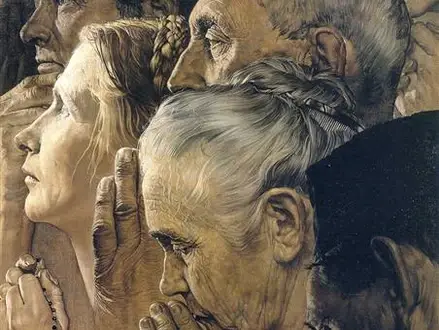Title of Artwork: “Freedom to Worship”

Artwork by Norman Rockwell
Year Created 1943
Summary of Freedom to Worship
This oil painting by American artist Norman Rockwell depicts the second of the four freedoms: freedom of worship or freedom to worship. Goals set forth by President Franklin D. Roosevelt in his State of the Union Address on January 6, 1941, were used as inspiration for the series.
One of Rockwell’s most popular paintings is this one and Freedom of Speech. Freedom of Worship appeared in The Saturday Evening Post on February 27th, 1943, alongside an essay by Will Durant.
All About Freedom to Worship
Oil paintings by Norman Rockwell, entitled Four Freedoms, depict the second of the four freedoms: freedom to worship. On January 6, 1941, Franklin D. Roosevelt delivered his State of the Union Address to the 77th Congress, known as the Four Freedoms. Only two of the four freedoms, freedom of speech and freedom of religion, are mentioned in the Constitution of the United States.
Four Freedoms became part of the United Nations charter after being incorporated into an Allies policy statement during World War II. An essay accompanying each painting appeared in the Saturday Evening Post for four consecutive weeks: February 20: Freedom of Speech; February 27: Freedom of Worship; March 6: Freedom from Fear; and March 13: Freedom of Thought (March 13).
Editor Ben Hibbs of the Washington Post chose Durant, a best-selling author at the height of his fame, to write the essay that goes along with Freedom of Worship. Durant was in the middle of writing The Story of Civilization, a ten-volume work he co-wrote with his wife Ariel Durant. Will Durant also taught classes in history and philosophy.
The series of paintings was eventually widely disseminated as a poster and played an important role in the United States government’s War Bond Drive.
An eight-figure portrait is depicted in a small space. They depict people from a variety of faiths in a quiet moment of contemplation In particular, the three Jews, Protestants, and Catholics depicted in the bottom row (from right to left): a man with his head covered holding a religious book, an older woman with a well-lit face holding rosary beads. When Rockwell illustrated JFK’s Bold Legacy for a Look magazine story in 1966, he drew inspiration from John F. Kennedy’s “Freedom of Worship.”
Kennedy is depicted in profile with Peace Corps volunteers in a composition reminiscent of Freedom of Worship.
Patrons of all faiths and races could be seen waiting in the barbershop in the original version of the painting. His first attempt was an oil painting measuring 41 by 33 inches (104 cm x 84 cm), in which he depicted tolerance as the “basis for religious diversity in a democracy.”
An Orthodox priest awaited the barber’s services while a Jew was being served by the Protestant barber. Since no one could agree on what a person of a particular religion should look like, it was difficult to paint portraits that could be instantly recognised by anyone of a different race or religion. In an effort to clarify the depiction of the characters, he found himself resorting to offensive overexaggeration, particularly of the non-clerical characters.
Relegating the black man to an agrarian workman’s attire and making the Jewish man appear stereotypically Semitic caused the work to be bogged down and did not speak on behalf of government as it should. Despite Rockwell’s stated intention of depicting religious tolerance, he felt that the original painting did not adequately convey this message.
Information Citations
En.wikipedia.org, https://en.wikipedia.org/.






















